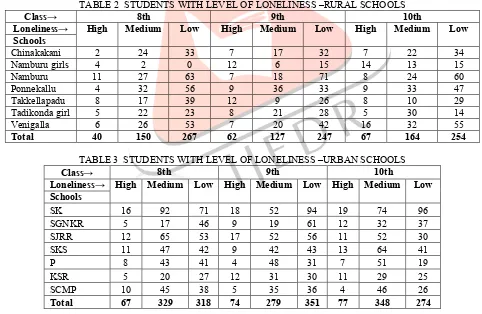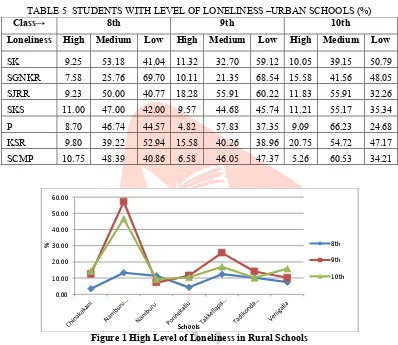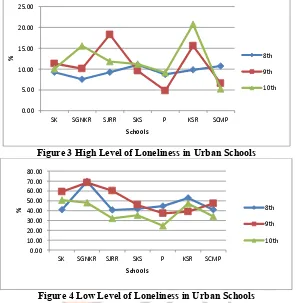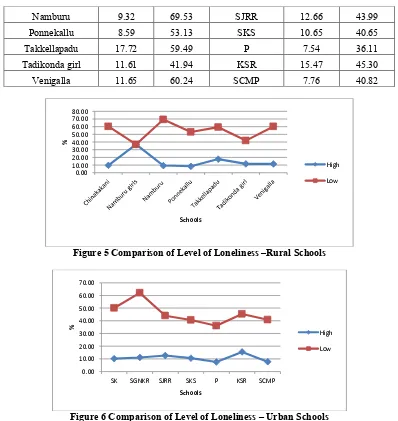IJEDR1901080 International Journal of Engineering Development and Research (www.ijedr.org) 445
Loneliness In High School Students -A Case Study
Podila Sankara Pitchaiah, Nazia Sultana Professor, Research Scholar Acharya Nagarjuna University
_____________________________________________________________________________________________________ Abstract -Loneliness has been defined as an unpleasant experience that derives from important deficiencies in the lonely person’s network of social relationship. It is increasingly becoming a major concern in modern societies. The researchers found a relation between loneliness and physical and mental health and academic achievement. A total of 3485 students were participated, out of them 1368 are studying (8th to 10th classes) in rural schools and 2117 in urban
schools. Statistical tools were used to analyze the data. The study found that the loneliness problem is more in rural students than urban.
Keywords: Loneliness, effects, coping strategies, rural and urban, high school students
I. INTRODUCTION
Loneliness has been defined as 'the unpleasant experience that occurs when a person's network of social relationships is significantly deficient in either quality or quantity (Perlman and Peplau, 1984).
Lin and Huang (2012) reviewed the various definitions for loneliness. Loneliness is a common problem for many students. It has been defined as an unpleasant experience that derives from important deficiencies in the lonely person’s network of social relationship. Research indicates that loneliness is associated with relatively poor physical health and depression among students. Long term loneliness can easily have adverse effects on students, such as low satisfaction in life and learning achievements, and a negative impact on their physical and mental health.
Loneliness or perceived social isolation is a subjective experience relating to dissatisfaction with one’s social relationships. Most research has focused on the experience of loneliness in old age, but levels of loneliness are also known to be high among teenagers and young adults. While poor health may be associated with increased feelings of loneliness, there is now considerable evidence on the role of loneliness as a risk factor for poor mental and physical health (Shankar, 2017). Human beings have a fundamental need for belongingness (Sunny et al., 2018).
Sawir et al., (2008) stated that not every lonely person has the “same” loneliness. The perception of loneliness, and the way people cope with it, vary among individuals and between cultural groups: not only by personality but also because of differing practices in relationships. Between two people in much the same circumstances, the incidence and intensity of loneliness can vary. In fact, one may feel lonely and the other not. Loneliness is a subjective experience in that it does not necessarily simply isolation, but instead is the result of self-perceived deficiencies in social relationships. The factors which relate to the loneliness at the cognitive level can be listed as: one’s own negative feeling about himself/herself, the increase of the irrational opinions, not being able to control the life and fatalism (McWhirter, 1997).
Loneliness is increasingly becoming a major concern in modern Western societies. Severe loneliness (reporting feeling lonely ‘almost all of the time’ or ‘most of the time’) affects 6% of the adults in the UK (Victor & Yang, 2012) with further estimates suggesting that loneliness is a chronic state (often conceptualised as an enduring experience that has lasted for at least 2 years; Young, 1982) for 15%–30% of the general population (Hawkley & Cacioppo 2010; Heinrich & Gullone, 2006).
The present study was carried out to observe the level of loneliness among the Government rural and urban high schools, located in and around Guntur Municipal Corporation, India.
II. CAUSES
According to Sawir et al., 2008 the main causes were the absence of intimate persons and lack of cultural fit. A smaller number referred to difficulties in securing social networks and Personal Psychology. A lack of belonging in the group, feeling lonely, and self-denial are three major factors that cause loneliness (Wang, 1989). In brief, when an individual experiences surrounding social interaction that is not what they expected, loneliness will occur. Loneliness is not just limited to social isolation; it is possible that an individual can still feel lonely among groups (Pinquart and Sorensen, 2001).
III. EFFECTS
People may experience problems like anxiety, frustration, emotional disturbances, depressions and various other psychosomatic difficulties (Sunny et al., 2018). Vasileiou et al., (2019) presented various effects of loneliness from literature. Defined as the distressing experience arising from discontent with the level and quality of social connections (Perlman & Peplau, 1981), loneliness is linked to a series of adverse mental health outcomes. It is associated with depression, deliberate self-harm, suicidal ideation and engagement with unhealthy behaviors (e.g. smoking, alcohol use). Loneliness are also related to poor physical health outcomes, such as high blood pressure, poor sleep quality, an increased likelihood of mortality and increased risk of developing coronary heart disease and stroke.
IJEDR1901080 International Journal of Engineering Development and Research (www.ijedr.org) 446 stress related inflammatory and neuroendocrine response and has been identified as a major risk factor for hypertension. In addition, loneliness is predictive of depression and reported as a contributor to functional decline and mortality. Experiencing loneliness is traumatic as lonely people experience significant social stigma is more likely to be inactive and engage in substance use. Loneliness is a costly health care problem with lonely persons visiting emergency services clinics and long-term care facilities more frequently than those who are not experiencing loneliness.
IV. METHODOLOGY
A total of 3485 students was participated, out of them 1368 are studying (8th to 10th classes) in rural schools and 2117 in urban schools (Table 1). Students were assembled in a classroom of the respective schools and asked them to give their response to a question-“Do you feel comfort when state alone? Three options were provided, i.e., Always, Sometimes and Never. The purpose of the study and the details regarding loneliness were explained in their mother tongue. The response was analyzed using statistical analysis. Percent variation was observed and presented under results and discussion.
TABLE 1 SCHOOL WISE STUDENT’S STRENGTH
Rural Schools
Class Urban
Schools
Class
8th 9th 10th 8th 9th 10th
Chinakakani 59 56 49 SK 173 159 189
Namburu girls 30 21 30 SGNKR 66 89 77
Namburu 97 96 86 SJRR 130 93 93
Ponnekallu 92 78 86 SKS 100 94 116
Takkellapadu 64 47 47 P 92 83 77
Tadikonda girl 49 57 49 KSR 51 77 53
Venigalla 79 69 101 SCMP 93 76 76
V. RESULTS AND DISCUSSION
A percent variation of the rural and urban students, those feeling loneliness was shown in tables 2 to 5 and figures 1 to 4. In this section level of loneliness among the rural and urban schools is explained.
TABLE 2 STUDENTS WITH LEVEL OF LONELINESS –RURAL SCHOOLS
Class→ 8th 9th 10th
Loneliness→ High Medium Low High Medium Low High Medium Low Schools
Chinakakani 2 24 33 7 17 32 7 22 34
Namburu girls 4 2 0 12 6 15 14 13 15
Namburu 11 27 63 7 18 71 8 24 60
Ponnekallu 4 32 56 9 36 33 9 33 47
Takkellapadu 8 17 39 12 9 26 8 10 29
Tadikonda girl 5 22 23 8 21 28 5 30 14
Venigalla 6 26 53 7 20 42 16 32 55
Total 40 150 267 62 127 247 67 164 254
TABLE 3 STUDENTS WITH LEVEL OF LONELINESS –URBAN SCHOOLS
Class→ 8th 9th 10th
Loneliness→ High Medium Low High Medium Low High Medium Low Schools
SK 16 92 71 18 52 94 19 74 96
SGNKR 5 17 46 9 19 61 12 32 37
SJRR 12 65 53 17 52 56 11 52 30
SKS 11 47 42 9 42 43 13 64 41
P 8 43 41 4 48 31 7 51 19
KSR 5 20 27 12 31 30 11 29 25
SCMP 10 45 38 5 35 36 4 46 26
Total 67 329 318 74 279 351 77 348 274
Rural Schools 8th class
IJEDR1901080 International Journal of Engineering Development and Research (www.ijedr.org) 447 TABLE 4 STUDENTS WITH LEVEL OF LONELINESS –RURAL SCHOOLS (%)
Class→ 8th 9th 10th
Loneliness High Medium Low High Medium Low High Medium Low Chinakakani 3.39 40.68 55.93 12.50 30.36 57.14 14.29 44.90 69.39 Namburu girls 13.33 6.67 0.00 57.14 28.57 71.43 46.67 43.33 50.00 Namburu 11.34 27.84 64.95 7.29 18.75 73.96 9.30 27.91 69.77 Ponnekallu 4.35 34.78 60.87 11.54 46.15 42.31 10.47 38.37 54.65 Takkellapadu 12.50 26.56 60.94 25.53 19.15 55.32 17.02 21.28 61.70 Tadikonda girl 10.20 44.90 46.94 14.04 36.84 49.12 10.20 61.22 28.57 Venigalla 7.59 32.91 67.09 10.14 28.99 60.87 15.84 31.68 54.46
TABLE 5 STUDENTS WITH LEVEL OF LONELINESS –URBAN SCHOOLS (%)
Class→ 8th 9th 10th
Loneliness High Medium Low High Medium Low High Medium Low SK 9.25 53.18 41.04 11.32 32.70 59.12 10.05 39.15 50.79 SGNKR 7.58 25.76 69.70 10.11 21.35 68.54 15.58 41.56 48.05 SJRR 9.23 50.00 40.77 18.28 55.91 60.22 11.83 55.91 32.26 SKS 11.00 47.00 42.00 9.57 44.68 45.74 11.21 55.17 35.34
P 8.70 46.74 44.57 4.82 57.83 37.35 9.09 66.23 24.68
KSR 9.80 39.22 52.94 15.58 40.26 38.96 20.75 54.72 47.17 SCMP 10.75 48.39 40.86 6.58 46.05 47.37 5.26 60.53 34.21
Figure 1 High Level of Loneliness in Rural Schools 9th class
High percent of Namburu girls’ school students (57.14) expressed that they prefer loneliness (Figure 1), followed by Takkellapadu (25.53). Low percentage of Namburu (7.29) and Venigalla students (10.14) marked the problem. 46.15 % of Ponnekallu followed by 36.84% of Tadikonda girls’ pointed that sometimes they like loneliness (Figure 2). As a whole, high percent of students do not prefer loneliness (Ex. Namburu:73.96; Namburu girls’ 71.43).
Figure 2 Low Level of Loneliness in Rural Schools
0.00 10.00 20.00 30.00 40.00 50.00 60.00
%
Schools
8th
9th
10th
0.00 10.00 20.00 30.00 40.00 50.00 60.00 70.00 80.00
%
Schools
8th
9th
IJEDR1901080 International Journal of Engineering Development and Research (www.ijedr.org) 448 10th class
46.67 % of Namburu girls’ school students, pointed out that they feel comfort when stay alone (Figure 1). Namburu (9.30%) and Tadikonda girls’ students (10.20) recorded with less problem. 61.22 % of Tadikonda girl followed by 44.90% of Chinakakani students felt that they prefer loneliness sometimes (Figure 2). Similar to 8th and 10th class students, many students expressed that they are happy with more friends.
Urban Schools 8th class
High percent of SKS school students (11.00) expressed that they prefer to stay alone (Figure 3), followed by SCMP (10.75). Low percent of students from SGNKR (7.58) and P students (8.70) marked the problem. 53.18 % of SK, followed by 50.00% of SJRR pointed that sometimes they prefer loneliness. As a whole, high percent of students preferred to stay with friends (Figure 4), i.e., they cannot bear the loneliness (Ex: SGNKR: 69.70; KSR: 52.94).
Figure 3 High Level of Loneliness in Urban Schools
Figure 4 Low Level of Loneliness in Urban Schools 9th class
High percent of SJRR school students (18.28) expressed that they prefer to stay alone (Figure 3), followed by KSR (15.58). Low percent of students from P (4.82) and SCMP students (6.58) marked the problem. 57.83 % of P, followed by 55.91% of SJRR pointed that sometimes they prefer loneliness (Figure 4). As a whole, high percent of students preferred to stay with friends, i.e., they cannot bear the loneliness (Ex: SGNKR: 68.54; SJRR: 60.22; SK: 59.12).
10th class
High percent of KSR school students (20.75) expressed that they prefer to stay alone (Figure 3), followed by SGNKR (15.58). Low percent of students from SCMP (5.26) marked the problem. 66.23 % of P, followed by 60.53% of SCMP pointed that sometimes they prefer loneliness (Figure 4). As a whole, high percent of students preferred to stay with friends, i.e., they cannot bear the loneliness (Ex: SK: 50.79; SGNKR: 48.05).
Comparison between Rural and Urban (8th to 10th)
A minimum of 8.59% (Ponnekallu) to a maximum of 37.04% (Namburu girls’) expressed the loneliness problem in rural schools (Table 6 and Figure 5). These percentages are 7.54 (P) and 15.47 (KSR) respectively. It is found that the problem is low in Ponnekallu, Namburu and Chinakakani among the rural and P, SJRR, SCMP and SKS in the case of urban schools (Figure 6).
TABLE 6 COMPARISON OF LONELINESS - RURAL AND URBAN
Residence → Rural (%) (8th to 10th ) Urban (%) (8th to 10th )
Schools
Loneliness
Schools
Loneliness
High Low High Low
Chinakakani 9.76 60.37 SK 10.17 50.10
Namburu girls 37.04 37.04 SGNKR 11.21 62.07
0.00 5.00 10.00 15.00 20.00 25.00
SK SGNKR SJRR SKS P KSR SCMP
%
Schools
8th
9th
10th
0.00 10.00 20.00 30.00 40.00 50.00 60.00 70.00 80.00
SK SGNKR SJRR SKS P KSR SCMP
%
Schools
8th
9th
IJEDR1901080 International Journal of Engineering Development and Research (www.ijedr.org) 449
Namburu 9.32 69.53 SJRR 12.66 43.99
Ponnekallu 8.59 53.13 SKS 10.65 40.65
Takkellapadu 17.72 59.49 P 7.54 36.11
Tadikonda girl 11.61 41.94 KSR 15.47 45.30
Venigalla 11.65 60.24 SCMP 7.76 40.82
Figure 5 Comparison of Level of Loneliness –Rural Schools
Figure 6 Comparison of Level of Loneliness – Urban Schools
Hebebci and Shelley (2018) studied the relationship between problematic Internet use and loneliness. The findings of the study revealed that while university students’ social benefit/social comfort of Internet has a direct effect on their excessive Internet use and negative consequences, it is related to the loneliness level indirectly. In addition, it is seen in the research model that with an increase in the negative consequences of the Internet, the loneliness level was raised. Another result from the study is that when university students’ excessive Internet use increased, their loneliness level decreased.
Sutin et al., (2018) examined whether loneliness is associated with risk of dementia in the largest sample to date and further examines whether the association is independent of social isolation, a related but independent component of social integration, and whether it varies by demographic factors and genetic vulnerability. The results indicated that loneliness was associated with a 40% increased risk of dementia.
Rosenstreich and Margalit (2015) examined whether the mindfulness practice may moderate the relations between perceived loneliness and academic performance. The results suggested that mindfulness practice may reduce the outcomes of loneliness on academic achievements in the first year of college.
Shankar (2017) show that loneliness is associated with an increased risk of developing dementia and chronic diseases, and also with a higher rate of mortality. Richardson studied in relationship between loneliness and menatal health in students with reference to British undergraduate students. The results showed that greater loneliness predicted greater anxiety, stress, depression and general mental health over time. There was no evidence that mental health problems increased loneliness over time.
Massoom and Bajestani (2016) examined loneliness and depression in students who regularly care for themselves after school (latchkey students) and compared with students who enjoy the parent’s company in Mashhad. Using the Pearson correlation test, significant correlation between depression and loneliness was observed among latchkey students (r = 0.59, P ≤ 0.05). However, no significant difference between loneliness and depression was observed (r = 0.02. P ≥ 0.05) in non-latchkey students.
Daniel (2013) examined the predictive role of attachment styles on loneliness and depression. Attachment styles were found to be significantly correlated to loneliness and depression. A significant relationship was also found between loneliness and depression.
Coping Strategies
0.00 10.00 20.00 30.00 40.00 50.00 60.00 70.00 80.00
%
Schools
High
Low
0.00 10.00 20.00 30.00 40.00 50.00 60.00 70.00
SK SGNKR SJRR SKS P KSR SCMP
%
Schools
High
IJEDR1901080 International Journal of Engineering Development and Research (www.ijedr.org) 450 Vasileiuoua et al., (2019) reported that participants used a variety of coping strategies to manage the distressing experience of loneliness. Accommodation, mainly in the form of distraction, support-seeking, social isolation, self-reliance, and problem-solving behaviours were the most prevalent coping strategies mentioned. Coping reflecting helplessness, escape, submission, and more rarely, opposition, were also found, albeit less often.
Masssoom and Bajestani, (2016) concluded that mothers who spend most of their time working out of the house and deprive their children of their presence at home may cause some form of mental distress like loneliness and depression in youngsters. Ahmad Gul (2017) studied to loneliness levels and their academic anxiety at the college level. He suggested that researchers suggest that the psychological counselling and guidance services of colleges must be functionalized and improved to moderate students’ academic anxiety and to decrease loneliness level.
Various Coping Strategies were reviewed by Sawir et al., (2008). The strategies and resources people use in coping with loneliness, which vary among individuals and among cultural groups, are the object of much research.
The present study found that considerable percent of both rural and urban students suffering from loneliness problem. It is also observed that the problem is more in rural students comparatively.
IV. CONCLUSION
Loneliness problem is commonly found in students. Out of the total 1368 rural students responded, 169 students expressed high level of loneliness (12.35%). In the case of urban 218 students marked high against the total 2117 (10.30%). As the problem is correlated with physical and mental health, in addition to the student’s academic achievement, counseling shall be arranged in the schools.
References
[1] Ahmad Gul Showkeen Bilal (2017) A Study Of Loneliness And Academic Anxiety Among College Students, The Communications, Vol. 25, No. 2, pp. 85-89.
[2] Daniel Kasomo (2013) Loneliness and Depression among University Students in Kenya, Global Journal of Human Social Science Arts & Humanities Volume 13 Issue 4 Version 1.
[3] Hawkley, L. C., Thisted, R. A., Masi, C. M., & Cacioppo, J. T. (2010). Loneliness predicts increased blood pressure: 5-year cross-lagged analyses in middle-aged and older adults. Psychology and Aging, 25, 132–141. https://doi.org/10.1037/ a0017805.
[4] Hebebci Mustafa Tevfik , Shelley Mack (2018) Analysis of the Relationship between University Students’ Problematic Internet Use and Loneliness International Journal of Assessment Tools in Education, Vol. 5, No. 2, 223– 234.
[5] Heinrich, L. M., & Gullone, E. (2006). The clinical significance of loneliness: A literature review. Clinical Psychology Review, 26, 695–718. https://doi.org/10. 1016 /j.cpr.2006.
[6] Lin Shu-Hui and Huang Yun-Chen (2012) Investigating the relationships between loneliness and learning burnout, Active Learning in Higher Education 13(3) 231–243.
[7] Massoom S.S.F and Bajestani H.S (2016) Loneliness and Depression in Self-Care Students in Mashhad Northeastern Iran, International Journal of School Health: April 01, 2016, 3 (2); e32115.
[8] McWhirter, B. T. (1997). Loneliness, learned resourcefulness, and self-esteem in college students, Journal of Counseling & Development, 75, 460-469.
[9] Perlman, D and Peplau, L.A (1984) Loneliness research: survey of empirical findings, in: L.A. PEPLAU & S.E.G OLDSTON(Eds) Preventing the Harm@ Consequences of Severe and Persistent Loneliness (Washington, DC, US Government Printing Office).
[10] Pinquart M and Sorensen S (2001) Influences on loneliness in older adults: A meta-analysis. Basic and Applied Social Psychology 23(4): 245–66.
[11] Rosenstreich Eyal and Margalit Malka (2015) Loneliness, Mindfulness, and Academic Achievements: A Moderation Effect among First-Year College Students, The Open Psychology Journal 8, (Suppl 2-M11) 138-145. [12] Sawir Erlenawati, Marginson Simon, Deumert Ana, Nyland Chris and Ramia Gaby (2008) Journal of Studies in
International Education; 12; 148.
[13] Shankar Aparna (2017) Loneliness and Health, 10.1093/acrefore/9780190236 557.013.122.
[14] Sunny Aleena Maria, Jacob Julia Grace, Neha Jimmy, Drishya Theres Shaji, Cilvania Dominic (2018) Emotional Maturity Variation among College Students with Perceived Loneliness, International Journal of Scientific and Research Publications, Volume 8, Issue 5, pp. 233-252.
[15] Sutin Angelina R., Stephan Yannick, Luchetti Martina and Terracciano Antonio (2018) Loneliness and Risk of Dementia, Journals of Gerontology: Psychological Sciences,Vol. XX, No. XX, 1–9.
[16] Vasileioua Konstantina, Julie Barnetta, Manuela Barretob, John Vinesd, Mark Atkinsonb, Kie Longd, Lyndsey Bakewelle, Shaun Lawsonf, Michael Wilsone (2019) Coping with loneliness at University: A qualitative interview study with students in the UK, Mental Health & Prevention 13, 21–30.
[17] Victor, C. R., & Yang, K. (2012). The prevalence of loneliness among adults: A case study of the United Kingdom. The Journal of Psychology, 146, 85–104. https://doi.org/10. 1080/00223980.2011.613875.
[18] Wang YR (1989) The loneliness and related factors for the college students. Chiayi Teachers College Journal 3: 1– 53.
IJEDR1901080 International Journal of Engineering Development and Research (www.ijedr.org) 451 [20] Theeke Laurie, Carpenter Roger D., Mallow Jennifer, Theeke Elliott (2019) Gender differences in loneliness, anger,



